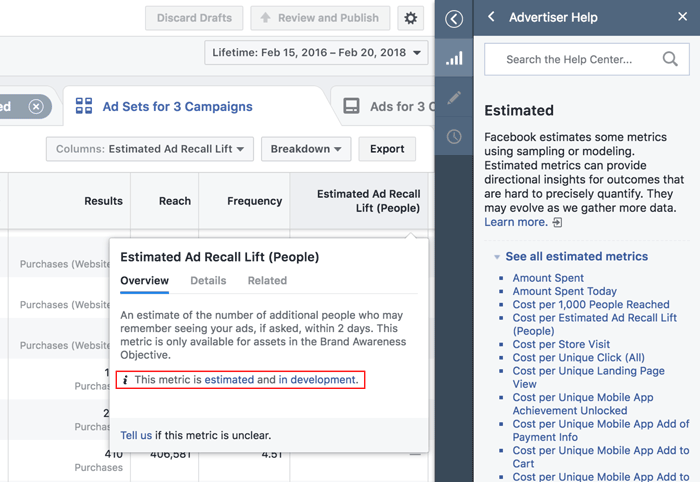The Facebook Ads Manager provides a lot of metrics that you rarely use, offer little value, or are totally redundant and just take up space.
Facebook agrees and is making huge changes to their Ads Manager.
In this article, I’ll talk about the new updates Facebook has made to the Business Manager and what it means going forward.
Facebook to remove 20+ metrics
Facebook stated they will remove 20+ metrics that they believe are redundant, outdated, hardly used, or provide the advertiser with very few actions to take.
Facebook’s goal is to reduce the clutter in your Ads Manager to help you focus on the metrics that really matter.
So what will they be removing? Here’s a list:
- Actions
- People Taking Action
- Cost Per Any Action
Facebook suggests you create your own composite metrics that actually matter to your business instead, as the above metrics do not provide much relevance.
- Amount Spent Today
To view how much you spent each day you can still use the date selection and gather the information from the Amount Spent metric.
- Button Clicks
- Canvas Component Time Percentage
- Carousel Card
- Link Click Destination
Button clicks and link clicks destination are pretty much the same thing, but most of us tend to look at link clicks or the amount of event responses/saved offers they got per click.
Canvas View Time and Canvas View Percentage provide advertisers with a much clearer metric on how their Canvas ad types are performing, so they will remove the above.
- Mobile App Actions Conversion Value
This is another redundant metric. It’s better if you use the Mobile App Purchases Conversion Value.
- Page Mentions
- Cost Per Page Mention
- Page Tab Views
- Cost Per Page Tab View
These are all vanity metrics that fail to provide you with information on whether consumer sentiment for your brand is positive or negative.
- Positive Feedback
- Negative Feedback
Relevance score already takes into account positive and negative feedback. However, the fact that you can have adverts with a relevance score of 10 but high negative feedback can confuse advertisers, and therefore it is being removed.
- Social Reach
- Social Impressions
- Social Clicks
- Unique Social Clicks
These social metrics can be seen in the Reach or Impressions Tab and Facebook plans to remove them too.
Estimated or In-Development metrics
As well as clearing out the old, Facebook is also bringing together two new metrics: Estimated and In-Development.

(Source)
Estimated metrics will provide advertisers with calculations on how many people they will reach or what Facebook estimates your cost per action will be based on sampling or modelling.
Estimated labels are there to give advertisers some direction on outcomes that are very difficult to quantify.
For example, the way Facebook provides you the Reach metric for campaigns is by seeing how many people view the same ad multiple times, duplicate them, and find the total number of unique impressions in real time.
To provide you with faster metrics, the Reach metric will be labelled as Estimated.
In-Development metrics are metrics Facebook is currently testing using machine-learning algorithms and polling. These metrics can change as Facebook gathers more data and will be marked as In-Development.
What’s coming in the future?
Facebook is also working on a new program they call Measure What Matters. This program will be used to help brands focus on their primary goal, be that brand objectives or direct response.
Measure What Matters hopes to provide clearer metrics to help brands plan, deliver, and measure their entire Facebook strategy to help them reach their overall goal.
What do you think about the new changes to the Ads Manager?